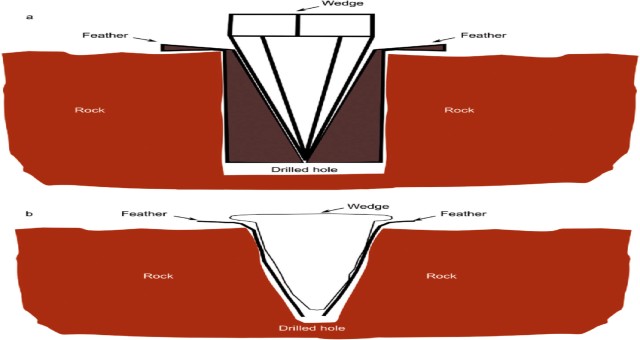The process of taking out stones from natural rock beds is known as the quarrying. The term quarry is used to indicate the exposed surface of natural rocks. The stones, thus obtained, are used for various engineering purposes. The difference a mine and quarry should be noted. In case of a mine, the operations are carried out under the ground at great depth. In case of quarry, the operations are carried out at ground level in an exposed condition.
SITE FOR QUARRY-The selection of site for a quarry of stones should be done after studying carefully the following aspects:
- Availability of tools, power, materials and labour for the efficient working of quarry.
- Easy availability of clean water in sufficient quantity all the year round.
- Economy in quarrying.
- Drainage of quarrying pit.
- Facility of carrying and conveying stones from quarry.
- Quality of stone available from quarry.
PROCESS OF QUARRYING-Following are the three methods of quarrying:
- Quarrying with hand tools
- Quarrying with channelling machine
- Quarrying with blasting
QUARRYING WITH HAND TOOLS-There three methods of doing this type of quarrying:
- Digging or Excavating
- Heating
- Wedging
(a) Digging or Excavating- In this method, the stones are merely excavating with the help of suitable instruments such as pick-axes, hammers, shovels, chisels, etc. This method is useful when a soft stone occurs in form of large and small blocks.
(b) Heating- In this method, the top surface of rock is heated. This method is useful when small blocks of more or less regular shape are to be taken out from quarry. It is suitable when the rock formation consists of horizontal layers of shallow depth. It is possible to obtain by these method fairly rectangular blocks required for coursed rubble masonry.
(c) Wedging-In this method, if rock surface contains cracks or fissures,the steel wedges or points, as shown in fig., are driven through such cracks by means of hammers. The blocks of stones are then shifted and they are removed with the help of suitable instruments.The wedging is adopted for costly stratified rocks which are comparatively soft such as laterite, marble, limestone, sandstone, etc. The wedging is preferred to the blasting, wherever possible.
QUARRYING WITH CHANNELING MACHINE: In this method, the channelling machine driven by steam, compressed air or electricity are used to make vertical or oblique grooves or channels on the rock mass. These machines make rapidly the grooves having length of about 24m, width of about 50mm to 75mm and depth of about 2.40m to 3.70m. The process consists of the following steps:
(a) The channels are cut around the stone block which is to be removed from the rock mass.
(b) The horizontal holes are drilled beneath the rock.
(c) The wedges are driven into the holes and the block is then broken loose from its bed.
QUARRYING WITH BLASTING: In this method, the explosives are used to convert into small pieces of stones. The main purpose of quarrying stones by is to loosen large masses of rocks and not to violently blow up the whole mass so as to convert it into very small pieces of practically no use. This method is adopted for quarrying hard stones, having no fissures or cracks. The stones obtained by blasting are usually of small size and they are used as ballast in railways, aggregate for concrete, road metal, etc. The process of blasting is important with respect to the stone quarrying.
